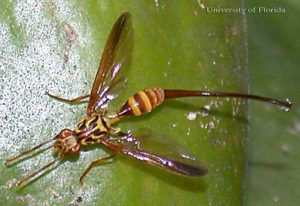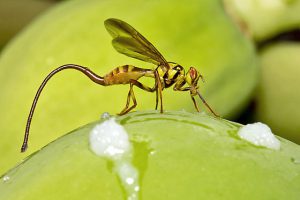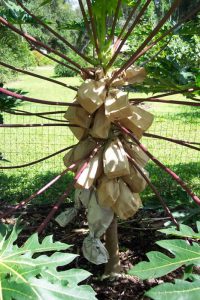Papaya fruit fly, Toxotrypana curvicauda Gerstaecker, is the major pest of papaya (Carica papaya L.) throughout the tropical and subtropical areas. The insect was reported in Florida in 1905. It first was observed in Florida Keys and Miami, then spread throughout the state wherever papayas are grown.
The papaya fruit fly is yellow marked with back and commonly mistaken for a vespid wasp due to its size. The female can produce 100 or more eggs. The female fruit fly oviposits in the green immature fruit by thrusting her ovipositor through the flesh of the fruit. She then deposits a group of 10 or more long, slender eggs in the papaya’s central cavity where the young larvae feed on developing seeds and the interior parts of the fruit. As the larvae mature, they eat their way out of the fruit, drop to the ground beneath the plant, and pupate just below the soil surface. Flies emerge in about two to six weeks, depending upon humidity and temperature of the soil. Fruit infected with papaya fruit fly larvae will turn yellow and drop from the tree prematurely.



Management
Prevention of egg-laying is the key to controlling papaya fruit fly. It is necessary to kill the adult female before she deposits eggs in the fruit. Bagging can be an effective control measure for the fruit fly in small plantings. Bagging should begin when the fruit is small. Each fruit should be enclosed in a paper bag or rolled tube of newspaper and tied around the stem. This method can be very practical and successful if enough labor is available.
Sanitation is also important in the control of the papaya fruit fly. All dropped and prematurely ripe fruit, as well as infested young fruit, must be destroyed in order to prevent the larvae from developing into adults.
More information is here
 0
0
